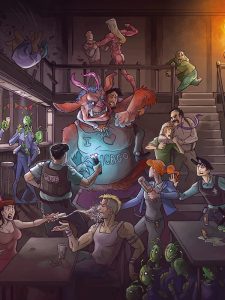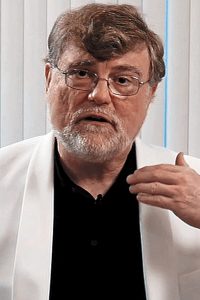Spotlight on Raya Golden

 Raya Golden has a unique and stylized vision and brings her work into the world using a variety of mediums ranging from watercolors to digital multimedia. In 2014 she did a comic based on George R.R. Martin’s story ‘‘The Meathouse Man’’. It was nominated for a Hugo Award for best graphic novel. In 2015 she released her first full length graphic novel, Starport, an adaptation of a 1994 TV pilot script by Martin. Most recently she’s completed her second graphic novel adaptation, Voyaging Vol. 1: The Plague Star. During her numerous journeys she has shown at multiple galleries in California, Montana, Colorado, and numerous conventions, as well as making countless logos, T-shirt designs, album covers, and so on. She also managed to graduate from the Academy of Art in San Francisco with a focus on digital and traditional illustration. She currently resides in Santa Fe NM with her cats Mr. Boogie and Mz. Boop and hopes to further her career in comic book illustration.
Raya Golden has a unique and stylized vision and brings her work into the world using a variety of mediums ranging from watercolors to digital multimedia. In 2014 she did a comic based on George R.R. Martin’s story ‘‘The Meathouse Man’’. It was nominated for a Hugo Award for best graphic novel. In 2015 she released her first full length graphic novel, Starport, an adaptation of a 1994 TV pilot script by Martin. Most recently she’s completed her second graphic novel adaptation, Voyaging Vol. 1: The Plague Star. During her numerous journeys she has shown at multiple galleries in California, Montana, Colorado, and numerous conventions, as well as making countless logos, T-shirt designs, album covers, and so on. She also managed to graduate from the Academy of Art in San Francisco with a focus on digital and traditional illustration. She currently resides in Santa Fe NM with her cats Mr. Boogie and Mz. Boop and hopes to further her career in comic book illustration.

What was your introduction to working in the field of science fiction and fantasy art? What were the influences that drew you in?
I was born and raised in Manhattan while my mother, Wanda June, was an editor at Tor books. She was most definitely my introduction to SF and fantasy as a whole. She brought home cover art and comic books and all sorts of wonderful images for me to pore over. The two that drew me in the most as a child were prints of Carl Lundgren’s ‘‘Take the ‘A’ Train’’ and Frank Frazetta’s ‘‘Death Dealer’’. She definitely opened the door for me artistically and nurtured that talent her whole life, introducing me to other influential artists such as Tom Kidd, Wendy Pini, Edward Gorey, and Brian Froud.
Talk a bit about your work on Voyaging Volume One: The Plague Star! This book has such epic sweep and you had to create so many environments. Where do you go for visual inspiration when inventing worlds?
I am a research hound when it comes to the fabrication of worlds. I tend to saturate myself with other successful images or films to help me build my environments. When it came to Voyaging, I spent a lot of time with Halo’s concept art, Titan A.E, and the Alien franchise films. These were definite influences, but it’s clear I added many others into the mix while creating a feeling in each unique location. Most importantly I want my environments to feel both accurate and plausible, so perspective, scale, and framing is always on my mind when creating each panel and page.

As a graphic novelist, how do you build characters and create consistency throughout the book? What’s your favorite part of working on graphic novels?
I always start a new story line with a set of character drawings. Usually I do a full standing pose as well as several facial expressions and costuming options. From these initial drawings, I try to keep a consistent look throughout each page and panel, frequently checking back to my initial studies. My personal favorite part of working on a graphic novel is definitely inking splash pages – these classically overworked, and wonderfully detailed full-page illustrations are just plain fun all around, and always give any artist a good excuse to show off a little.
What does your workflow look like from concept to realization, and do you use digital media? Any unusual techniques?
I’m not sure there is a standard format for comic illustration these days, especially in graphic novels, which usually consist of far smaller teams of artists than traditional monthlies like Marvel and DC storylines. I usually draw each panel separately and physically on non-photo blue graph paper to maintain perspective and such. Once I have a set of ten pages worth of panels drawn, I scan them all and put the panels and pages in Photoshop. Doing the panel drawings separately gives me the flexibility to ensure each page flows well. Then I ink the pages digitally with a program called Clip Studio Art – this program has excellent pen options. and although I move around a lot, I usually find myself working with variations of a classic turnip pen most often. I would say it’s almost impossible to do traditional inking today on your own, and while I know how, I tend to work digitally to make sure I can meet my deadlines.
What does your ideal art project look like, if you had all the time in the world, and could work on anything you wanted to?
I’ve always wanted to do my own sweeping graphic novel storyline; I have a rough outline in place but would need help with the overall structure from an actual writer to make sure it was up to snuff for publication. It’s entitled The Misadventures of Princess Immagene and spans the lifetime of a genetically enhanced future princess of what’s left of a fallen planet. It’s a dream for which I have copious notes, but have made very little constructive headway with. Mostly I lack monetary motivation for this project, so if you know anyone who wants to play, feel free to reach out anytime.
How do you keep it fresh for yourself and keep learning new techniques and improving your craft? Have there been any recent changes or discoveries in your art process, or do you feel settled into something that’s really working for you already?
I try to be crafty when I can, watching YouTube videos and trying new things. Lately I’ve wanted to try learning how to do design embroidery and making some cute animal patches, just for fun. Each new tool in an artist’s belt means a new way to express themselves and inspire others to do the same. For comic illustration, I am hoping to improve my Procreate skills, as that will no doubt give me access to a larger digital toolset.
Interview design by Francesca Myman
Read the full interview in the June 2024 issue of Locus.
 While you are here, please take a moment to support Locus with a one-time or recurring donation. We rely on reader donations to keep the magazine and site going, and would like to keep the site paywall free, but WE NEED YOUR FINANCIAL SUPPORT to continue quality coverage of the science fiction and fantasy field.
While you are here, please take a moment to support Locus with a one-time or recurring donation. We rely on reader donations to keep the magazine and site going, and would like to keep the site paywall free, but WE NEED YOUR FINANCIAL SUPPORT to continue quality coverage of the science fiction and fantasy field.
©Locus Magazine. Copyrighted material may not be republished without permission of LSFF.







